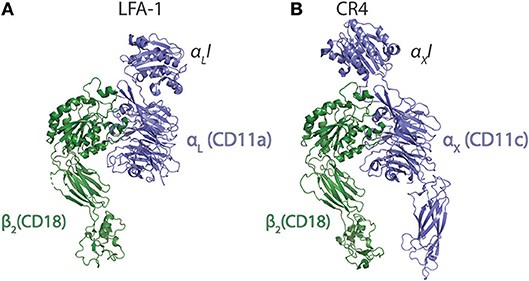Introduction
Complement receptors are membrane proteins, expressed either on or in the cells that drive or regulate immune responses. Interaction with complement receptors activates and regulates the function of immune and stromal cells. Complement receptor activation drives and controls the development of adaptive immune responses towards pathogens, allergens, autoantigens, and altered self-molecules through the induction of primary B and T lymphocyte responses.
ITGAX encodes a heterodimer of integrins αX (CD11c) and together with integrin β2 chain (CD18) form leukocyte-specific transmembrane glycoproteins, complement receptor 4 (CR4). CR4 (also known as αXβ2, CD11c/CD18) is a member of the integrin superfamily of adhesion receptors, responsible for cell-cell interactions and adhesion to extracellular matrices. They are similar to leucocyte function-associated molecule 1 (LFA-1, CD11a/CD18), so-called β2 integrins and contain the same β subunit. The receptors are unique among the integrin family in having specificity and affinity for complement C3 activation products (iC3b).
Structure of ITGAX
The CR4 α subunit (CD11c) has a sequence identity with CR3 and is encoded by the ITGAX gene. ITGAX is a 150 kDa type I transmembrane glycoprotein, in which an N-terminal extracellular β-propeller domain with a series of globular domains, a single transmembrane segment, and a relatively short cytoplasmic tail consist of 1081 amino acids, 26 amino acids, and 29 amino acids, respectively. The ITGAX combines with the smaller, shared β2 chain (CD18) to being heterodimeric transmembrane glycoprotein. The heterodimeric ectodomain undergoes a conformational change in order to switch the receptor from an inactive state into an extended ligand-binding active state. CR4 could bind several structurally unrelated proteins, engineered peptides, and glycosaminoglycans and binds strongly negative-charged species.

Fig. 1 Comparison of the LFA-1 and CR4 (αXβ2).1, 2
Distribution of ITGAX
ITGAX is expressed in the myeloid subsets of leukocytes, but it is also found in NK cells and activated T and B lymphocytes. Like CR3, CR4 (ITGAX) is present on neutrophils, eosinophils, basophils, monocytes (macrophages), natural killer cells, Kupffer cells, microglial cells, cytotoxic T cells, and platelets.
Function of ITGAX
The ITGAX belongs to the integrin family and performs probably significant functions not only in phagocytosis but also in leukocyte trafficking and migration, synapse formation, and co-stimulation. The expression of ITGAX is commonly used to identify classical DC. ITGAX plays a pivotal role in cellular signaling and immunoregulation of multiple inflammatory diseases by T cell activation and cytokine production. The propensity of ITGAX to bind ligands containing exposed, acidic side chains may facilitate the recognition of denatured protein, fibrinogen, and damaged tissue. Besides, ITGAX is demonstrated to be a treatment biomarker to predict response to a TNF inhibitor drug in rheumatoid arthritis patients, and the variants of ITGAX are eventually involved in the susceptibility of IgAN and the inflammatory response during the development of IgAN.
ITGAX as A Drug Target
The expression of ITGAX is demonstrated to enable complement-dependent cell cytotoxicity toward antibody-coated cancer cells as part of biological therapy, constituting a significant part of the efficacy of such treatment. There are several products about ITGAX as a drug target for research and therapeutic applications, which are offered by Creative Biolabs, including but not limited to:
-
Monoclonal/polyclonal antibody
-
Recombinant ITGAX protein
-
ITGAX peptide
If you are interested in complement receptor ITGAX, please do not hesitate to contact us for more details.
References
-
Vorup-Jensen, Thomas, and Rasmus Kjeldsen Jensen. "Structural immunology of complement receptors 3 and 4." Frontiers in immunology 9 (2018): 2716.
-
under Open Access license CC BY 4.0, without modification
For Research Use Only.
Related Sections:

